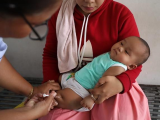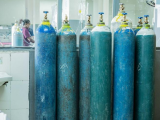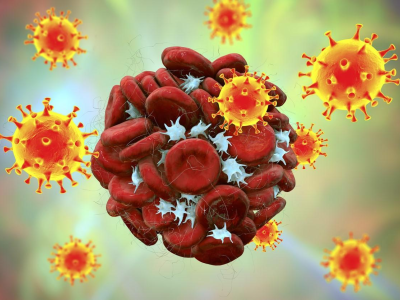Editor's note: This is part 1 of a 2-part series on tracking drug supply chain issues. The follow-up story, focusing on the Resilient Drug Supply Project at CIDRAP, was published Apr 18.
Five years ago, US Pharmacopeia (USP) began building a generic drug supply chain dataset to inform its strategic planning. Then the COVID-19 pandemic began, and the organization began analyzing the frequency of orders for its physical reference standards to gauge how the initial outbreak in China was affecting the pharmaceutical supply chain worldwide.
Seeing its potential, USP invested several million dollars into the dataset, morphing it into something much bigger: a tool that can be used to predict medicine shortages, identify the drivers behind them, and determine the most beneficial solutions.
The Medicine Supply Map contains more than 40 datasets from sources such as the US Food and Drug Administration (FDA) and regulatory agencies in four other countries, about 200 shortage risk factors suggested by expert volunteer consultants, and roughly 250 million data points covering 92% of generic medicines, said Vimala Raghavendran, MBA, head of the USP Pharmaceutical Supply Chain Center.
"We've been mapping the risk from raw materials and intermediates and their effects on the supply chain," she told CIDRAP News. "Our focus is on the upstream part of the supply chain risk, where manufacturing occurs."
Based in Rockville, Maryland, USP establishes primary quality reference standards used at more than 22,000 international sites for use in drug development and manufacturing.
One finding: India major supplier of APIs
In addition to basic information on each drug, Raghavendran said, the database contains information on such topics as the complexity of making and storing each drug, price, the critical raw materials in each drug, where its active pharmaceutical ingredients (APIs) and the finished drug are made, and the quality record of the facilities that make the drug.
In addition to strengthening drug supply chains against natural disasters such as a pandemic, the map could also shore up those under stress from warfare and trade wars, especially for critical drugs such as those for pediatric cancer, most of which don't have clinical substitutes. The likelihood of a shortage of such drugs is 90% higher than that of other drugs, according to a September 2021 USP report.
Ten USP data scientists and external consultants have been aggregating, curating, and enriching the model, which forecasts shortages of drugs such as intravenous sodium chloride, which is currently in shortage and has a 92% chance of still being in short supply over the next year, according to the Medicine Supply Map.
The drivers of the projected sodium chloride shortage are price (34.0%), quality issues (22.6%), competition (15.6%), complexity (11.3%), and geography (8.5%), the map shows. Such low-cost drugs may not generate enough profit for manufacturers to invest in upgrading their facilities, which can lead to compromised drug quality and recalls.
Another example is what Raghavendran calls "low-cost generic injectable drug x." The predicted likelihood of shortage for that unnamed drug in the next year is 31%, driven by complexity (9.7%), quality (9.0%), geography (7.1%), price (3.6%), and competition (1.6%). "Very few manufacturers make it," she said. "The solution for this drug might be different for that for sodium chloride."
Of the many findings gleaned from the map so far, Raghavendran said one of the most surprising has been the relative role of India and China in API manufacturing of drugs supplied to the United States. "When we analyzed API manufacturing for generics by looking at drug master files, we found that India is by far the biggest supplier of API to the United States," she said.
In fact, 114 facilities in India make more than 30 FDA-approved APIs, compared with 45 in Europe, 4 in China, and 3 in the United States. Among facilities with more than 10 such products, 183 are in India, 83 are in Europe, 35 are in China, and 19 are in the United States.
Another finding has been that the appetite for and effects of onshoring, or returning drug or API manufacturing to the United States, has been tepid, likely owing to its enormous expense and complexity. "There have been new [onshoring] additions to the US, but because we're talking about such a large base that the difference tends to be quite incremental," she said. "But it might be the right answer for low-cost generic injectable x."
Plans to expand accessibility to database
While the Medicine Supply Map is currently available only to USP data scientists, Raghavendran said the plan is to make it more widely accessible. "We do plan to issue periodic reports and maybe an annual report," she said.
In a Mar 16 press release, the organization said, "The Medicine Supply Map will be discussed in upcoming USP Convention meetings to identify specific solutions to increase supply chain resilience, develop recommendations to improve the continuous cycle of preparedness, including implications for national stockpiles, and increase international cooperation among supply chain partners such as governments and manufacturers."
In particular, Raghavendran sees a role for the map in US government planning for allocation of the billions of dollars reserved for shoring up the drug supply chain, efforts that may include onshoring. "They need a way to prioritize these investments, and we think the Medicine Supply Map can be really useful in making those choices," she said.
Manufacturers also may use the map to determine which drugs to make and identify the market opportunity for them. "We think that manufacturers, hospitals, and other supply chain intermediaries who have a role in making sure their patients have medicines could benefit from the Medicine Supply Map's insights and predictions about where medicine supply vulnerabilities lie," Raghavendran said. Such a move could help them prepare for a drug shortage, make allocations, and find alternative medications, all of which take time, she added.
As a nonprofit employing former pharmaceutical industry professionals and with staff in pharma hot spots such as India, China, and Europe to help contextualize the data, USP is uniquely positioned to offer drug supply mapping data, Raghavendran said.
"We're a convening organization and a standard-setting organization, so I think that's helpful as well because, ultimately, we believe that there's a role for a neutral organization that can take data to generate insights that help improve the resilience of the drug supply chain," she said.





















